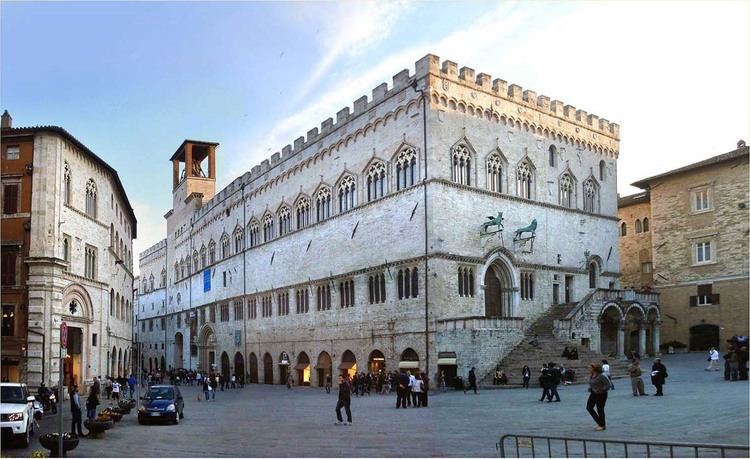Province Province of Perugia Function Palace | Phone +39 075 573 6458 | |
 | ||
Address Corso Pietro Vannucci, 19, 06100 Perugia, Italy Hours Open today · 9AM–7PMTuesday9AM–7PMWednesday9AM–7PMThursday9AM–7PMFriday9AM–7PMSaturday9AM–7PMSunday9AM–1PMMonday9AM–7PMSuggest an edit Architectural style Italian Gothic architecture Similar Fontana Maggiore, Galleria Nazionale dell'Umbria, Perugia Cathedral, Rocca Paolina, Piazza IV Novembre | ||
Siena hotel palazzo dei priori
The Palazzo dei Priori is a historical building in Perugia, Umbria, central Italy.
Contents
As in other Italian medieval communes, it was the seat of the priori ("first citizens"). This magistrature was established in Perugia in 1303: the palazzo had been called the Palazzo Nuovo del Popolo ("New Palace of the People") to that point. During intractable civic quarrels, a podestà might be established, housed in a separate structure, the Palazzo del Podestà, of which only the Loggia added by Braccio da Montone flanking the Cathedral of San Lorenzo e San Ercolano remains. When the palazzo of this rival to the power of the Priori burned in 1534, significantly, it was not replaced, but fragments from it were incorporated into the archbishop's palace, also fronting the main piazza.
The Magistratura dei Priori that was housed in the structure consisted of ten representatives of each of Perugia's main guilds from among the forty-four that existed, permitted a tenure of only two months. The money-changers, who were housed in their own adjoining quarters in the fifteenth century, had the privilege of always being represented among the Priori, and the merchants' guild was represented by two members instead of one. After the Salt War of 1540 with Pope Paul III, the Priori were renamed “Conservatori dell’Ecclesiastica Obbedienza” ("Keepers of Ecclesiastical Obedience") and, the Palazzo del Podestà having been destroyed, the Palazzo dei Priori became the seat of the Papal Legate, the new governor of Perugia. When Pope Julius III restored the Priori, the grateful Perugini commemorated him with the bronze statue next to the Cathedral.
The structure commands the corner where the main artery of medieval Perugia, Corso Vannucci, enters the city's main square; a first section was constructed in 1293-97, at first as the Palatium Novum Populi, the "new Palace of the People", with ten bays along the Corso and three facing the piazza. Two more bays and a grand entrance portal were added to the piazza façade in 1333-37, together with the arcaded loggia, where decrees were publicly read. Later in the fourteenth century the palazzo was extended along the Corso, with six bays and a richly carved entrance doorway worthy of a cathedral. Rising above, a tower surmounts and controls the arched access to Via dei Priori, the ancient way that descends to the Etruscan gateway, the Roman Porta Trasimena, which was Christianized as the Arca di S. Luca. A further section down the Corso was built in 1429-43, still keeping to the Gothic tripartite fenestration, to house the Collegio del Cambio, the "money exchange" that was the financial center of Perugia.
The perimeter of the roof was originally crenellated all around, less for actual defensive purposes than as a symbol of Perugia's independence. Significantly, the crenellations were removed in 1610, when Perugia had submitted at last to papal armies. When Perugia was joined to a united Italy, the crenellations were triumphantly restored.
The grand portal in the Piazza is surmounted by the city's symbols, the griffin of Perugia and the Imperial Guelf lion, in bronze; the originals were probably cast in the Arsenal of Venice, in 1274, the first European bronze castings in the round achieved since Antiquity. Above the door, strung on a bar hanging from chains the keys to the gates of Siena were triumphantly displayed, following the victory of Perugia at the battle of Torrita, 1358.
The portal leads to an austere vaulted undercroft with the stairs leading to the vaulted frescoed Sala of the former council chamber of the Priori on the piano nobile; the Sala was allocated to the notaries guild in 1582, as the Sala dei Notari, when their former quarters, the Palazzetto dei Notari, on the opposite side of the Corso were partially demolished in a street widening. On the left is the entrance to the Galleria Nazionale dell'Umbria one of the most outstanding provincial Italian collections of art.
